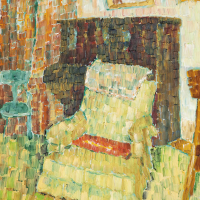21. GRACE COSSINGTON SMITH

Were Grace Cossington Smith to be alive today, she would probably have been unfazed by the prospect of spending months at home. Of course, Cossington Smith never had to run the gauntlet of Zoom calls or home-schooling though she was a devoted carer to her sister Diddy, who fell ill in the years leading up to her death in 1962. Cossington Smiths radiant still-lifes and interiors of the 1950s and 60s broadly considered to mark the culmination of her career point to the extraordinary creative possibilities of a life spent largely indoors. Throughout this period, the artist worked almost exclusively from a studio next to her bedroom at Cossington her family home in Turramurra on Sydneys upper North Shore. This sedate domestic setting would provide the impetus for some of her most inventive works, which revealed a fresh and unbridled approach to colour and light. As Cossington Smith recalled of her final years with Diddy, We were both content and happy in our life at home. I found quite enough to paint.1
In Piano and Chair, an otherwise mundane domestic scene is spectacularly brought to life through Cossington Smiths unique sensibility for colour and light. The paintings entire surface shimmers with tiny square brushstrokes of yellow, brown, orange and green. Our eye is immediately drawn to the scarlet cushion of the vacant chair, which appears to hover in space. The orange curtain on the left is dramatically shot through with touches of turquoise from an adjacent chair, while the carpet is a vivid patchwork of green and gold. Cossington Smiths use of colour achieves its impact through variation and contrast: similar shades are clustered together and set against their direct opposites. Curator Deborah Hart writes that the artists embrace of vibrant, non-referential colour during the 1950s and 60s reflects a sense of liberation in growing older, freed from the pressures of having to prove herself.2
Cossington Smiths interiors and still-lifes often bear a meditative quality, born from the artists renewed attention to the domestic and familiar. Objects of art, crockery and furniture reappear in works created years apart, painted each time with slight variations in colour or viewpoint. The same yellow armchair may be seen in Portrait over the Writing Desk 1961 (formerly in the Grundy collection) and Cushions on the Sofa 1969 in the Orange Regional Gallery, New South Wales.3
Piano and Chair originates from the collection of Enid Cambridge, a fellow artist and Cossington Smiths dearest friend. A wonderfully serene portrait from 1957, Enid on the Sofa, bears affectionate testament to their friendship of many decades.4
Footnotes:
1. Grace Cossington Smith, quoted in Hart, D., Radiance: A State of Being, in Grace Cossington Smith: A Retrospective Exhibition, National Gallery of Australia, Canberra, 2005, p.80
2. Hart, D., Radiance: A State of Being, in Grace Cossington Smith: A Retrospective Exhibition, p.88
3. Each illus. in Grace Cossington Smith: A Retrospective Exhibition, p.90
4. Hart, D., Radiance: A State of Being, p.83
Catherine Baxendale